El Qasr - Timetravel to a Medieval Islamic City
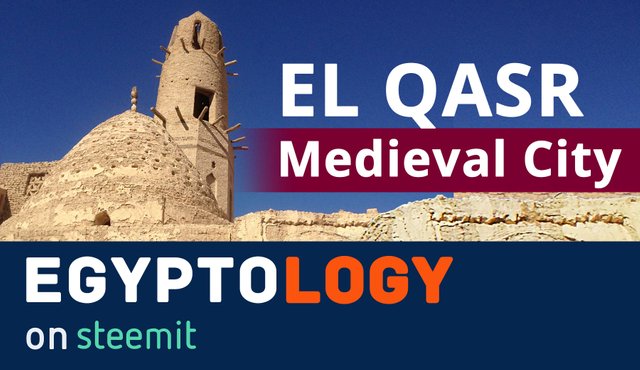
Dear readers, today I take you with me on a journey through the time after the pharaonic period in Egypt. The Dakhla oasis that I presented you two posts ago has many more interesting historical places worth visiting and in this article, the Ancient City of El Qasr is our destination.
A City with a Great History
El Qasr is – beside Mut – the second city in the Dakhla Oasis. For those who missed the previous posts (see here and here), I strongly encourage you to have a look at them as they give an introduction to the location and history of the oasis. As a short reminder and for your orientation you can find the map of most of the oases in Egypt below.
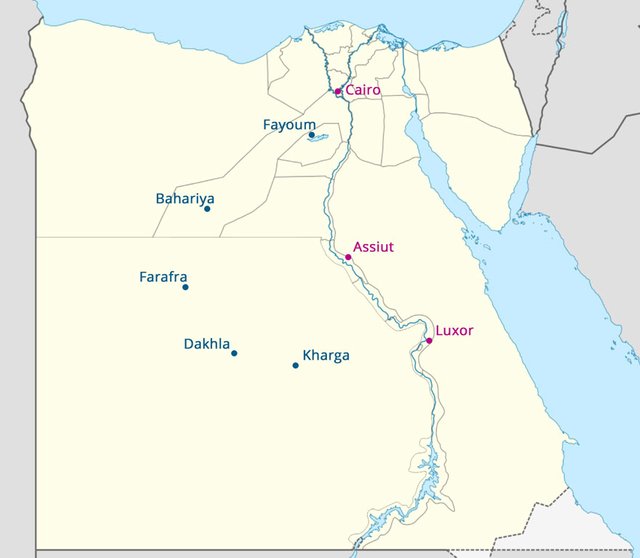
El Qasr was built around in the medieval/ottoman time (around 13th century A.D.) and belongs to the most important cities dating back to the early Islamic period. It is completely made of natural mudbrick and is mostly very well preserved. An interesting fact is that a few hundred people still live in this kind of buildings and give visitors a natural smile.
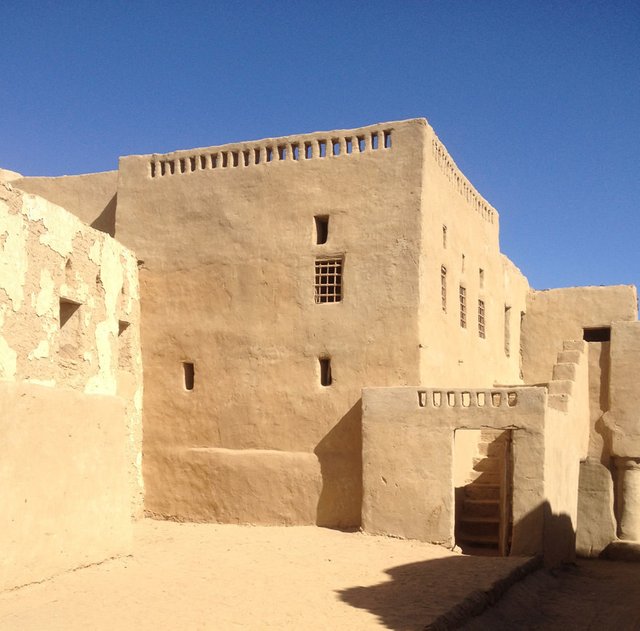
El Qasr in Detail
A central spot within the city is the Sheikh Nasr Edeen Mosque in the south of El Qasr. It was created in the traditional Ayyubi style. The mosque is about 7x9 meter in a rectangle shape with a pulpit of mudbrick. A door left to the entrance leads to the mausoleum with the body of Sheikh Nasr Edeen.

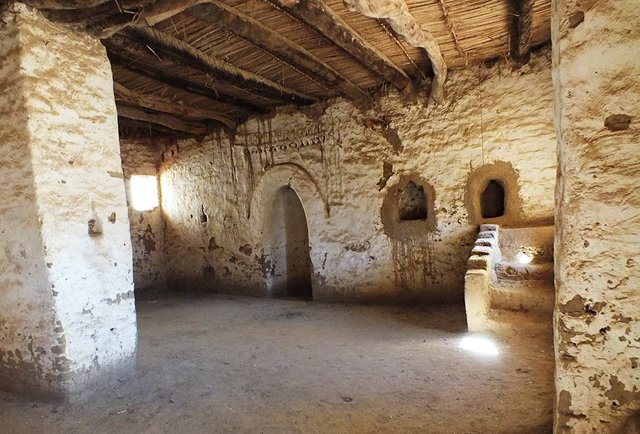
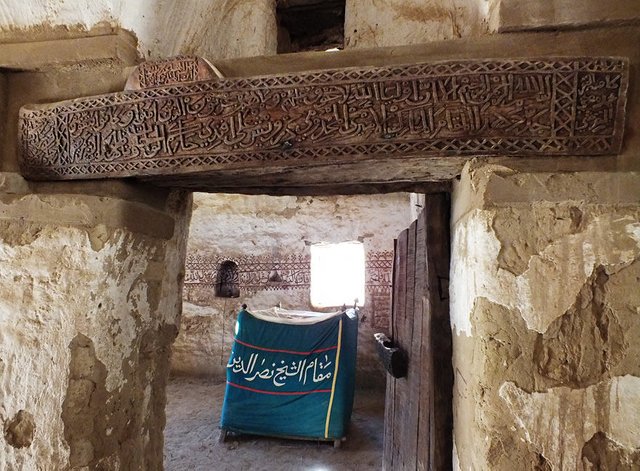
The flourishing city of El Qasr was once the home of thousands of people that mostly lived from agriculture. Their tools are still preserved such as the succulents – a two-step device to produce finest olive oil. The first step was done by a device to probably remove the seeds of the olives (the "juicer"). It was possibly driven by animals. In the second part, the olives were crushed. A pottery vessel in front of the device that was made of wooden clogs caught up the oil from the squeezer.
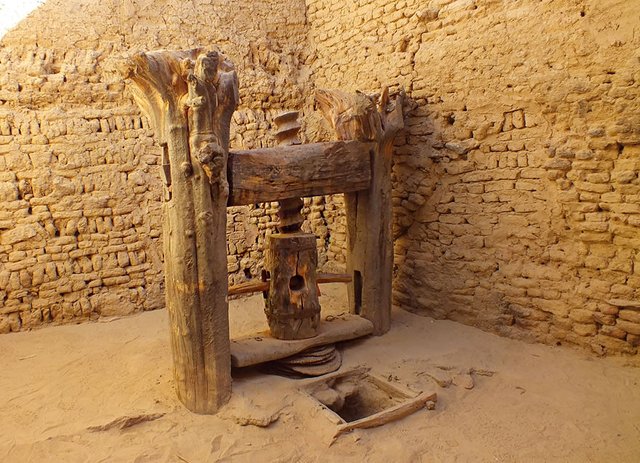
Another mechanical device was used for grain processing. This you usually can see only in ancient movies about the desert, but this device still works! I show you here a very small clip of how people produced flour in ancient times.
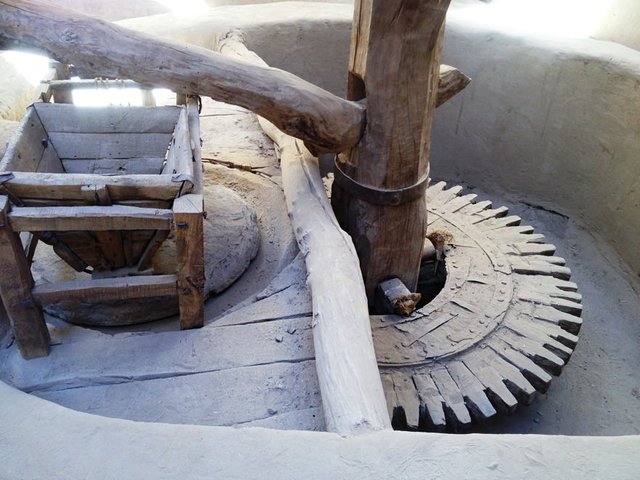
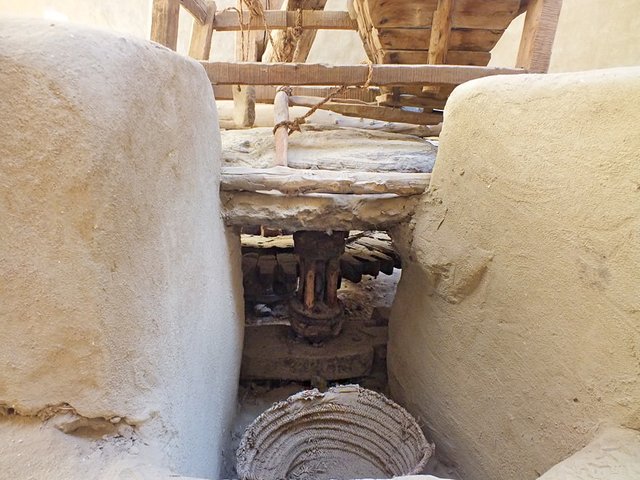
Traces of education and other parts of the social life are still visible such as the "madrassa" – which was once a school for Qur'an students and contained a huge library. Later on, it became a courtroom. Two chambers for prisoners waiting for their trial (one for males and another one for females) are directly connected with the courtroom.
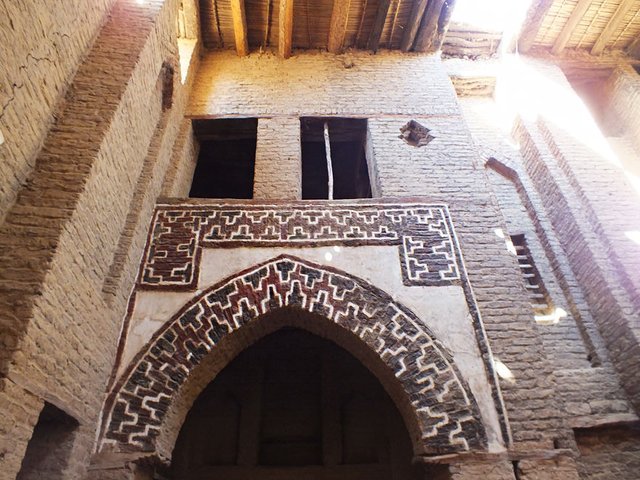
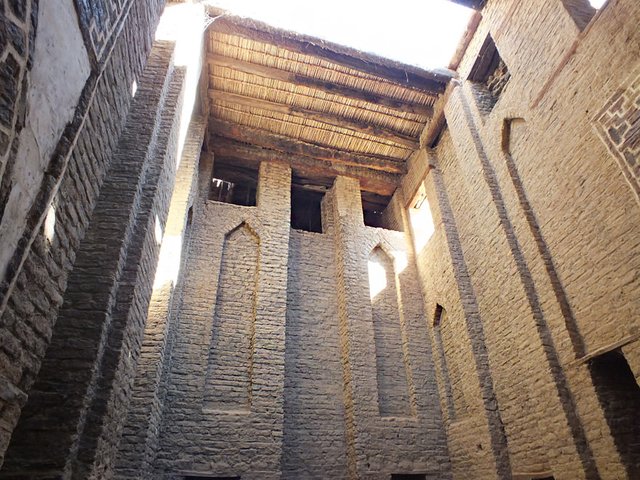
El Qasr has very narrow streets. This special architecture is built foremost to keep the inner city cool during heat waves in summer and also to protect it from being "flooded" with sand when the annual sandstorms are coming.

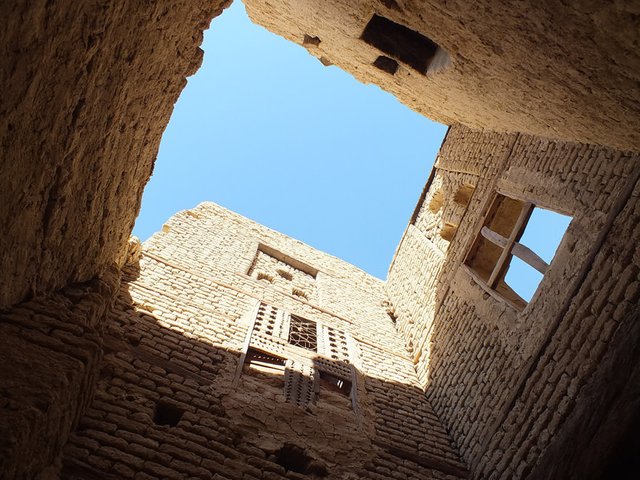
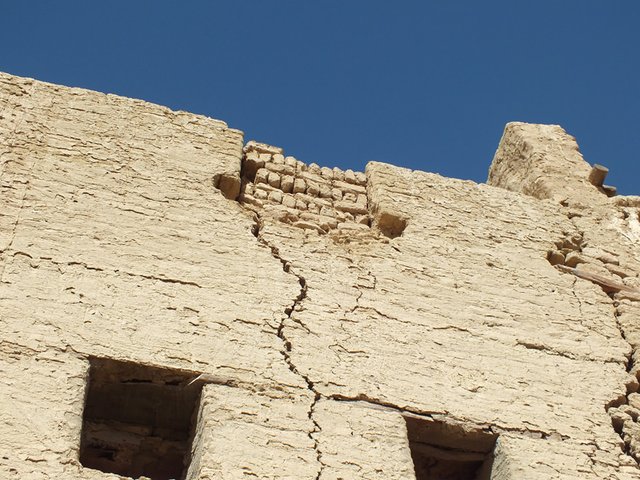
Spolia in El Qasr
Another interesting fact is that the inhabitants of El Qasr used limestone blocks from ancient temples such as Amheida (also located in Dakhla). These blocks are so-called spolia, which is of Latin origin spolium and literally means "robbed" or "looted from the enemy". The use of spolia is not new to the Islamic period. Already in ancient times, for example in Tanis, the City of Psusennes the II, spolia were found from Quantir, the city of Ramses II.
It was not always some kind of disrespect to older rulers and their buildings, but often also just a form of "recycling".
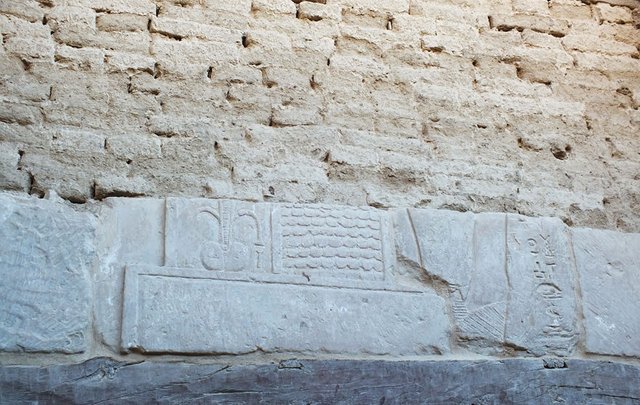
A Strange Species – Fruit Bats
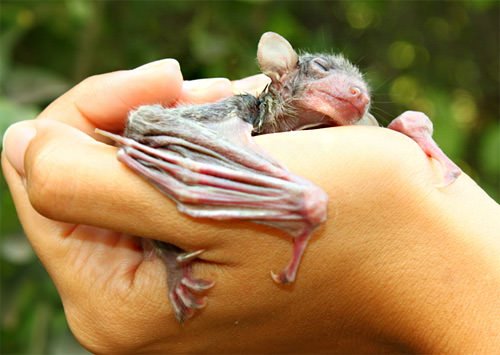
Do you want to know more about El Qasr? Feel free to ask questions in the comment section and let's discuss! :)
Sources:
• Information from the local visitor's guide.
• On fruit bats: https://en.wikipedia.org/wiki/Egyptian_fruit_bat
• http://www.egypt.travel/attractions/al-qasr/
• Further reading on spolia in Egypt: https://www.witpress.com/elibrary/ha-volumes/1/3/1224
• Further reading on the egyptian oases in general: Boozer, Anna Lucille, Frontiers and Borderlands in Imperial Perspectives: Exploring Rome's Egyptian Frontier, In: American Journal of Archaeology, Vol. 117, No. 2 (April 2013), pp. 275–292. DOI: 10.3764/aja.117.2.0275
Image sources:
• Map of Egypt (edited by the author): Source CC BY-SA 3.0
• Egyptian Fruit Bat: Source CC BY-SA 3.0
• All other photos and video taken by myself on 4th Jan. 2018.
Feel free to ask all the question of what you always wanted to know about Ancient Egypt. That’s my job and my passion. Let’s discuss your thoughts and ideas.

If you liked this article, please follow me on my blog @laylahsophia. I am a german Egyptologist writing about ancient and contemporary Egypt, history of science, philosophy and life.
wow so nice place
I love this type of architecture. Can you explain why are pillars sticking out of that tower? It looks great but it sure serves some purpose.
Hi @bachluslib, appreciate your question.
These are wooden elements to strengthen the outer walls of the minarett tower. Other sources say these sticks were put into the mudbrick wall to prepare a re-plastering of the fassade from time to time. So, the outer wall became thicker over the years. I would assume this architectural style comes from Africa since there are many ancient mosques shaped in this way. :)
excellent post I love you and I follow you, you already have my vote and my reesteem, greetings
ICh mag deine fachlichen Artikel und ich finde immer wieder die Verbindungen zu meinen Themen. Really great article my dear! It’s always a pleasure to read. Hugs
Dankeschön, Akashas. Das freut mich sehr!! 😍
Weißt du eigentlich wieviel Yoga und die ägyptische Kultur gemeinsam haben...? Verdammt viel....! Mach einfach weiter so my dear :-)
Echt jetzt? Ich dachte, Yoga kommt aus Asien. :D
OH, das überrascht mich aber jetzt...da dachte ich sogar das grad du das weißt! Der Ursprung fast aller Kulturen ist Ägypten....und alles was davor war, doch dieses ist schwer nachzuweisen, da es kaum noch Spuren gibt.
Auf alten ägyptischen Bildern sind klar Yoga Asanas (Positionen) abgebildet!
Ebenso die Rituale stammen von der selben esssnz ab.
Sehr interessant oder?
Yoga ist ebenso ein schlangenkult, wenn man so möchte. Die Kundalini oder patanjali ...siehe Ägypten! :-) die Verbindungen sich hoch interessant und falls es dich mal packt und du darüber einen Artikel verfasst, freut es mich umso mehr. Es waere interessant was du da so findest. Hugs
Echt interessant! Einerseits bin ich als Ägyptologin natürlich freudig überrascht über solche Zusammenhänge. Und die altägyptische Kultur hat in der Tat für vieles den Grundstein gelegt. Andererseits gab es zur selben Zeit auch noch andere Kulturen rund um den Globus, die ähnliche Kulte zur selben Zeit entwickelt haben.
Auch der Pyramidenbau ist zb. nichts, was Ägypten vorbehalten war. In Mittel- und Südamerika gibts ebenso große Monumente. Sie sehen nur anders aus. Und man muss aktuell davon ausgehen, dass sie keinen direkten Kulturkontakt miteinander hatten.
Insofern gibt es häufig auch sowas wie universale Zusammenhänge, die der menschlichen Spezies immanent zu sein scheinen. Also etwas, das tief in uns drin steckt. Das Aufsteigen der Kundalini ist ja eine Erfahrung, die grundsätzlich jeder Mensch auf die eine oder andere Weise machen kann. Gibt sogar Muslime, die spezielle Techniken entwickelt haben, um "high" zu werden ohne Drogen – und zwar ohne, dass sie es wissen (zb. im Sufi Zikr). Letztendlich streben wir bewusst oder unbewusst nach dieser Erfahrung. Dafür sind wir hier.
Glaube ich.
Who knows.
:)
MIr ist der Sufi Kult bekannt.
Auch die Ähnlichkeiten und die anderen Kulturen.
Ich bin ein Spezialist in nichts speziellen und weiß ein bisschen was zu den selben Ursprung, doch bist du der pro und es waere cooler so was wenn dann von dir zu lesen...:-)))
Hehe!
Schön eine solche kommunikations Partnerin zu haben. Danke
Und ob äußerer oder innerer drogenrausch...es wird das selbe bewirkt! Bei den Techniken geht es um das freisetzen gewisser Hormone im Gehirn/ zirbeldrüse!
Dieser Bereich ist für wach und schlaf Zustand wichtig und wird bei Geburt und Tod auch aktiv.
Das wussten die Ägypter wie yogis wie sufis wie Schamanen oder Indianer...;-))) Allgemeinwissen sozusagen.
Der Witz ist - die für war es Allgemeinwissen, für uns wurde es zu Geheimwissen. Ich mein, wir sprechen hier über mystische Dinge, die nicht in der Schule gelehrt werden heutzutage, die aber damals ein fester Bestandteil der Sozialisation waren.
Ich verstehe bis heute noch nicht genau, wie und warum das verlorengehen konnte...
Sehr interessant und super Bilder!
This is the first time i'm reading your blog in details and I must admit, I have missed a lot :). Better late than never though...
Yeah, you are welcome! :)
I upvoted done!!
Thank you very much.
The pictures are so beautiful! :)
From your post, this city is still old city style and i think interest to see more about this city @laylahsophia.